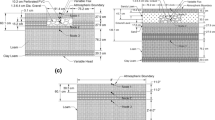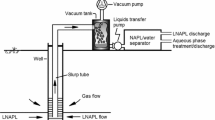Abstract
In-situ air sparging (IAS) is used for the clean-up of soil and groundwater that are contaminated with volatile organic compounds in relatively permeable subsurface environments. In this study, we investigated the secondary groundwater and gas flow fields that develop in the vicinity of single and multiple air sparging wells. The purpose is to evaluate their effects on contaminant plume migration and thus, remediation. Governing equations describing multiphase flow and contaminant transport in a three-dimensional domain were formulated and solved using the Galerkin finite element technique. Trichloroethylene was selected as a target contaminant. The increase in air injection contributed to an increase in the size of the IAS cone of influence and the gas saturation levels within the cone. This reduced the groundwater velocity within the cone and increased the zone of detour of groundwater around the air sparging wells. This outcome was quantified and compared under several IAS operations. Different soil permeability characteristics also affected the groundwater and gas flow patterns, and this impacted the remedial performance of the IAS system. Under high ambient groundwater velocity, an air sparging system that uses a single injection well caused the detour of contaminant plumes around injection wells, regardless of air injection rates, and failed to meet the remedial goal specified here. This system was successful for relatively low ambient groundwater velocity environments used here. An IAS system with multiple injection wells was effective in capturing and remediating the detoured contaminant plume, and showed superior performance when compared to a single injection well IAS system. Using IAS simulation, we also analyzed the impact of injection rates on site remediation using single or multiple wells. Design criteria that are based on the results of this study would be useful in enhancing the performance of the IAS systems.
Similar content being viewed by others
References
Bass D.H., Hastings N.A., Brown R.A.: Performance of air sparging systems: A review of case studies. J. Hazard. Mater. 72(2–3), 101–119 (2000)
Bear J.: Dynamics of Fluids in Porous Media. American Elsevier, New York (1972)
Bear J., Bachmat Y.: Macroscopic modeling of transport phenomena in porous-media .2. Applications to mass, momentum and energy-transport. Transp. Porous Media 1(3), 241–269 (1986)
Benner M.L., Mohtar R.H., Lee L.S.: Factors affecting air sparging remediation systems using field data and numerical simulations. J. Hazard. Mater. 95(3), 305–329 (2002)
Braida W., Ong S.K.: Influence of porous media and airflow rate on the fate of NAPLs under air sparging. Transp. Porous Media 38(1–2), 29–42 (2000)
Burnett R.D., Frind E.O.: Simulation of contaminant transport in 3 dimensions. 2. Dimensionality effects. Water Resour. Res. 23(4), 695–705 (1987)
Chen M.R., Hinkley R.E., Killough J.E.: Computed tomography imaging of air sparging in porous media. Water Resour. Res. 32(10), 3013–3024 (1996)
Clayton W.S.: Effects of pore scale dead-end air fingers on relative permeabilities for air sparging in soils. Water Resour. Res. 35(10), 2909–2919 (1999)
Daus A.D., Frind E.O., Sudicky E.A.: Comparative error analysis in finite-element formulations of the advection-dispersion equation. Adv. Water Resour. 8(2), 86–95 (1985)
Diersch H.J.G., Kolditz O.: Variable-density flow and transport in porous media: approaches and challenges. Adv. Water Resour. 25(8–12), 899–944 (2002)
Elder C.R., Benson C.H.: Air channel formation, size, spacing, and tortuosity during air sparging. Ground Water Monitor. Remediat. 19(3), 171–181 (1999)
Frind E.O.: Simulation of long-term transient density-dependent transport in groundwater. Adv. Water Resour. 5(2), 73–88 (1982)
Frind E.O.: Solution of the advection-dispersion equation with free exit boundary. Numerical Methods Partial Differential Eqn. 4, 301–313 (1988)
Hecht V., Brebbermann D., Bremer P., Deckwer W.D.: Cometabolic degradation of trichloroethylene in a bubble-column bioscrubber. Biotechnol. Bioeng. 47(4), 461–469 (1995)
Huyakorn P.S., Panday S., Wu Y.S.: A 3-dimensional multiphase flow model for assessing NAPL contamination in porous and fractured media. 1. Formulation. J. Contam. Hydrol. 16(2), 109–130 (1994)
Huyakorn P.S., Pinder G.F.: Computational Methods in Subsurface Flow. Academic Press, New York (1983)
Jang, W., Aral, M.M.: Three-dimensional Multiphase Flow and Multi-species Transport Model, TechFlowMP, Multimedia Environmental Simulations Laboratory, School of Civil and Environmental Engineering, Georgia Institute of Technology, Atlanta, GA, pp. 94 (2005)
Jang W., Aral M.M.: Density-driven transport of volatile organic compounds and its impact on contaminated groundwater plume evolution. Transp. Porous Media 67, 353–374 doi: 10.1007/s11242-006-9029-8 (2006)
Ji W., Dahmani A., Ahlfeld D.P., Lin J.D., Hill E.: Laboratory study of air sparging - air-flow visualization. Ground Water Monitor. Remediat. 13(4), 115–126 (1993)
Kirtland B.C., Aelion C.M., Widdowson M.A.: Long-term AS/SVE for petroleum removal in low-permeability Piedmont saprolite. J. Environ. Eng.-ASCE. 127(2), 134–144 (2001)
Lee C.H., Lee J.Y., Jang W.Y., Jeon Y.H., Lee K.K.: Evaluation of air injection and extraction tests at a petroleum contaminated site, Korea. Water Air Soil Pollut. 135(1–4), 65–91 (2002)
Lehmann F., Ackerer P.H.: Comparison of iterative methods for improved solutions of the fluid flow equation in partially saturated porous media. Transp. Porous Media 31(3), 275–292 (1998)
Lundegard P.D., Andersen G.: Multiphase numerical simulation of air sparging performance. Ground Water 34(3), 451–460 (1996)
Marley M.C., Hazebrouck D.J., Walsh M.T.: The application of insitu air sparging as an innovative soils and ground-water remediation technology. Ground Water Monitor. Remediat. 12(2), 137–145 (1992)
McCray J.E.: Mathematical modeling of air sparging for subsurface remediation: state of the art. J. Hazard. Mater. 72(2–3), 237–263 (2000)
McCray J.E., Falta R.W.: Defining the air sparging radius of influence for groundwater remediation. J. Contam. Hydrol. 24(1), 25–52 (1996)
Mei C.C., Cheng Z., Ng C.O.: A model for flow induced by steady air venting and air sparging. Appl. Math. Modell. 26(7), 727–750 (2002)
Mendoza C.A., Frind E.O.: Advective-dispersive transport of dense organic vapors in the unsaturated zone. 1. Model development. Water Resour. Res. 26(3), 379–387 (1990)
Millington R.J., Quirk J.P.: Permeability of porous solids. Trans. Faraday Soc. 57, 1200–1207 (1961)
Mohtar, R.H., Wallace, R.B., Segerlind, L.J.: Finite element simulation of oil spill cleanup using air sparging. In: Peter, A. (ed.) Computational Methods in Water Resource, X(2). Boston (1994)
Nyer E.K., Suthersan S.S.: Air sparging—Savior of ground-water remediations or just blowing bubbles in the bath tub. Ground Water Monitor. Remediat. 13(4), 87–91 (1993)
Panday S., Wu Y.S., Huyakorn P.S., Springer E.P.: A 3-dimensional multiphase flow model for assessing NAPL contamination in porous and fractured media. 2. Porous-medium simulation examples. J. Contam. Hydrol. 16(2), 131–156 (1994)
Parker J.C., Lenhard R.J., Kuppusamy T.: A parametric model for constitutive properties governing multiphase flow in porous-media. Water Resour. Res. 23(4), 618–624 (1987)
Peterson J.W., Murray K.S.: Grain-size heterogeneity and subsurface stratification in air sparging of dissolved-phase contamination: Laboratory experiments-field implications. Environ. Eng. Geosci. 9(1), 71–82 (2003)
Reddy K.R., Adams J.A.: Effects of soil heterogeneity on airflow patterns and hydrocarbon removal during in situ air sparging. J. Geotech. Geoenviron. Eng. 127(3), 234–247 (2001)
Roosevelt S.E., Corapcioglu M.Y.: Air bubble migration in a granular porous medium: Experimental studies. Water Resour. Res. 34(5), 1131–1142 (1998)
Thomson N.R., Johnson R.L.: Air distribution during in situ air sparging: An overview of mathematical modeling. J. Hazard. Mater. 72(2–3), 265–282 (2000)
Unger A.J.A., Sudicky E.A., Forsyth P.A.: Mechanisms controlling vacuum extraction coupled with air sparging for remediation of heterogeneous formations contaminated by dense nonaqueous phase liquids. Water Resour. Res. 31(8), 1913–1925 (1995)
van Dijke M.I.J., van der Zee S.E.A.T.M., van Duijn C.J.: Multiphase flow modeling of air sparging. Adv. Water Resour. 18(6), 319–333 (1995)
van Genuchten M.T.: A closed-form equation for predicting the hydraulic conductivity of unsaturated soils. Soil Sci. Soc. Am. J. 44(5), 892–898 (1980)
Waduge W.A.P., Soga K., Kawabata J.: Effect of NAPL entrapment conditions on air sparging remediation efficiency. J. Hazard. Mater. 110(1–3), 173–183 (2004)
Yeh G.T.: On the computation of Darcian velocity and mass balance in the finite-element modeling of groundwater-flow. Water Resour. Res. 17(5), 1529–1534 (1981)
Author information
Authors and Affiliations
Corresponding author
Rights and permissions
About this article
Cite this article
Jang, W., Aral, M.M. Multiphase Flow Fields in In-situ Air Sparging and its Effect on Remediation. Transp Porous Med 76, 99–119 (2009). https://doi.org/10.1007/s11242-008-9238-4
Received:
Accepted:
Published:
Issue Date:
DOI: https://doi.org/10.1007/s11242-008-9238-4




